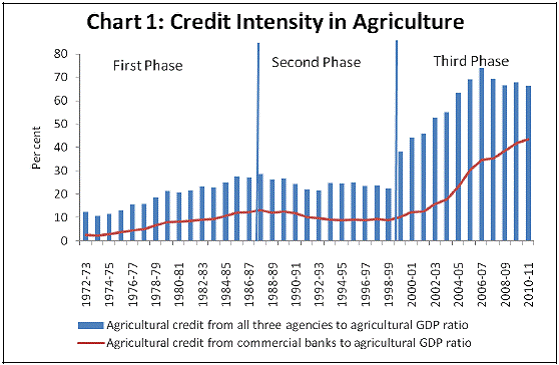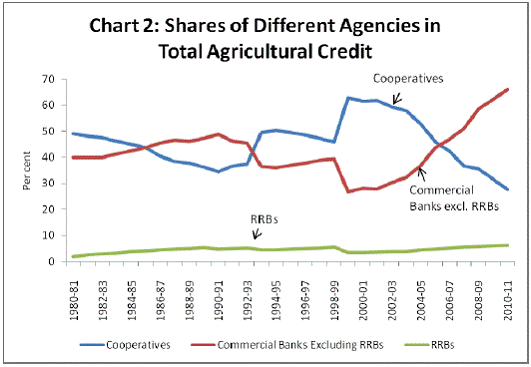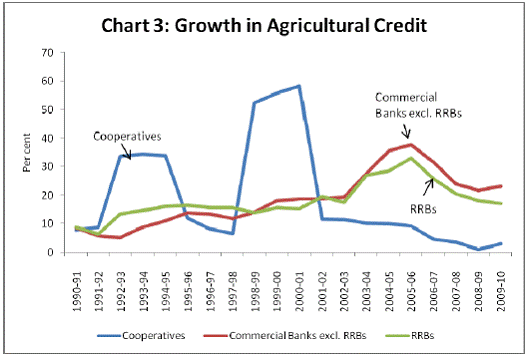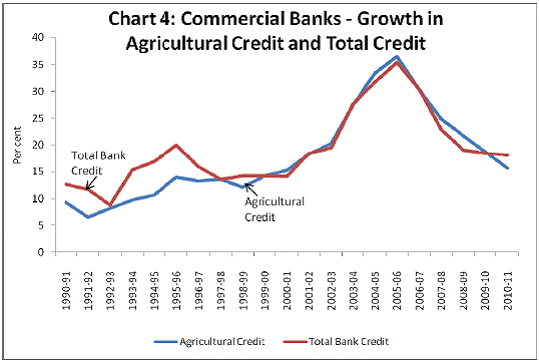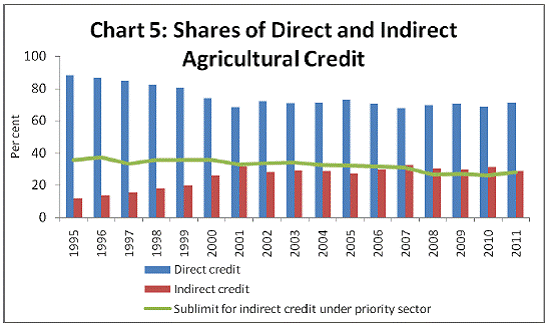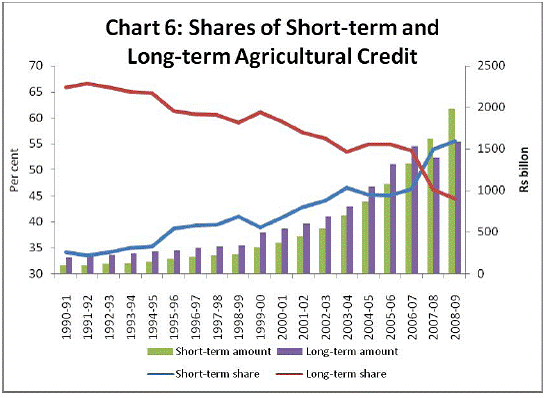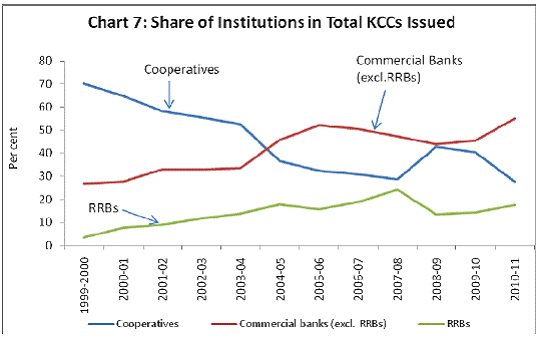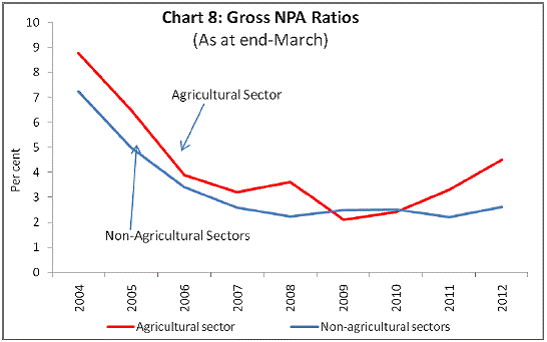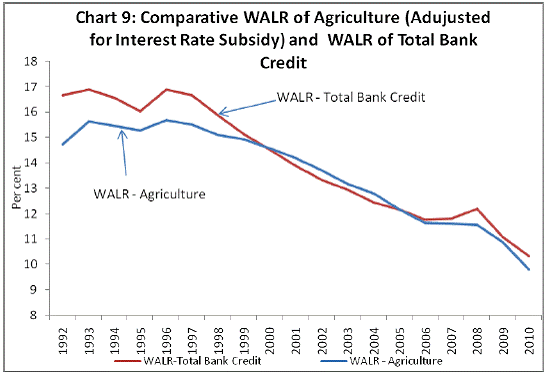Agricultural Credit - Accomplishments and Challenges - आरबीआय - Reserve Bank of India


Agricultural Credit - Accomplishments and Challenges
Dr. D. Subbarao, Governor, Reserve Bank of India
delivered-on जुलै 12, 2012
I am delighted to be a part of NABARD’s celebrations of its completion of thirty years. This is a special occasion for NABARD, of course; but also a special occasion for the Reserve Bank, for NABARD was incubated in the Reserve Bank before it rolled out as an independent development financial institution in 1982. The bondage between our two institutions has not only remained strong but is getting stronger. We share a common goal - of furthering inclusive growth. We also share significant professional domain because of our joint responsibility for the flow of agricultural credit. I. NABARD 2. Over the last three decades, NABARD has grown and evolved from a uni-dimensional apex financing agency into a multi-dimensional institution for shaping and implementing the country’s overall rural credit policy. NABARD has been a leader in promoting microfinance through the SHG-Bank linkage programme. By investing huge energies and manpower into this programme and drawing upon its myriad roles, NABARD has reached nearly 97 million households, making India’s microfinance programme the fastest, if not also the largest, in the world. All of you - management and staff of NABARD - including those who have retired can be proud of this very credible record of achievement of NABARD. My congratulations to all of you for serving this great institution so competently. 3. Completing three decades is an occasion for celebration; it is also an occasion for introspection - to look back on what you have accomplished and to look ahead to the challenges on the way forward. I thought the best way I can add value to NABARD’s celebrations is to do precisely that - to look back and look ahead on the challenges of agricultural credit - the quintessence of NABARD’s mandate. II. Importance of Agricultural Credit 4. Starting from Pandit Nehru’s exhortation soon after independence that ‘everything else can wait, but not agriculture’, agricultural growth has all along been central to India’s efforts at poverty reduction. We have come a long way from the chronic food shortages and occasional famines of the immediate post-independence years; even as the population has increased, we have been able to maintain food self-sufficiency through both extensive agriculture and productivity improvement. But in recent years, there has been growing concern about the erosion at the margins of food self-sufficiency. A big challenge for sustaining food self-sufficiency is raising production which, given that available land is fixed if not diminishing, has to come from improved productivity. A host of cash and non-cash inputs is necessary to improve productivity, and an important one is agricultural credit. 5. Development experience shows that credit is an important determinant of value added in agriculture. A quick assessment by the Reserve Bank of the relationship between institutional credit to agriculture (from commercial banks, cooperatives and RRBs) evidences positive and statistically significant elasticity - every 1 per cent increase in real agricultural credit results in an increase in real agricultural GDP by 0.22 per cent with a one-year lag.2 Further, the Granger causality test (based on lag length of 1) also indicates that the causality was unidirectional from agricultural credit to agricultural GDP. III. Looking Back - Major Policies for Promoting Agricultural Credit 6. In order to look ahead, it will be instructive to look back on the policies that shaped the flow of agricultural credit over the last 60 years. 7. In the first two decades after independence, the conduit for institutional credit to agriculture was the cooperative sector. Although sound in concept, the cooperative sector failed to live up to expectations. With the nationalisation of commercial banks, the decade of 1970s marked the entry of commercial banks into agricultural credit. This period saw the introduction of the Lead Bank Scheme and regulatory prescription of priority sector lending - two landmark development policies that survive even today. The 1970s also witnessed pilot experiments in specialised agency approach for directing credit to small and marginal farmers. The Small Farmers Development Agency (SFDA) and Marginal Farmers and Agricultural Labourers Development Agency (MFALDA) that were started in select districts of the country on a pilot basis had later been extended to the whole country as District Rural Development Agencies, which now play a central role in coordinating and managing the several poverty alleviation initiatives at the district level. 8. The economic reforms of the 1990s, starting with the first Narasimham Committee of 1991, emphasised financial soundness and operational efficiency of the financial sector - including rural financial institutions. The Reserve Bank gradually deregulated the interest rate regime to aid improvement in the operational efficiency of banks. The next two decades witnessed several important innovations in agricultural credit.
IV. Evolving Patterns in the Flow of Agricultural Credit 9. Having looked back on the policies that shaped agricultural credit, I will now highlight some of the broad outcomes of those policies. (i) Growing Role of the Formal Institutional Structure in Rural Credit 10. Over the years, there has been a striking increase in the share of formal financial institutions (commercial banks, RRBs and cooperatives) in the total credit availed by cultivator households. In the 1950s, non-institutional sources, particularly money lenders, accounted for virtually all the credit taken by cultivator households with only negligible credit flow from the formal institutional structure. This situation had changed dramatically by the early 1980s, with formal financial institutions accounting for as much as 60 per cent of the total credit [Table 1].3 11. The gradual increase in the share of formal institutional credit in agriculture witnessed some reversal in the period between 1991 and 2002 mainly because of a pull back by commercial banks. This disquieting trend is, in part, due to a contraction in rural branch network in the 1990s, and in part due to the general rigidities in procedures and systems of institutional sources of credit.412. Has there been a definite reversal of this trend after 2002? We have to wait for the findings of the next All India Debt and Investment Survey (AIDIS) to verify if the several new policy initiatives in the decade of 2000s for expanding the rural branch network and stepping up the supply of agricultural credit have resulted in commercial banks regaining the space they vacated in agricultural credit.
(ii) Increasing Intensity of Agricultural Credit 13. Over the last 40 years, there has been a striking increase in the credit intensity of agriculture as measured by the ratio of agricultural credit to agricultural GDP. The credit intensity increased from 12 per cent in the early 1970s to 67 per cent by 2010/11 [Chart - 1]. 14. Between 1970s and 2010, there were, in fact, three distinct phases in the behaviour of credit intensity. The first phase from early 1970s to the mid 1980s, saw a moderate increase in credit intensity. The second phase from the mid 1980s to late 1990s saw a declining trend. This was a period when the share of institutional sources in total debt of cultivator households was also on a decline as already illustrated with the help of AIDIS data in Table 1. By contrast, in the third phase starting 2000, there was a marked increase in the credit intensity of agriculture.
(iii) Growing Share of Commercial Banks in Total Agricultural Credit Starting 1980s 15. Among the institutional sources of agricultural credit, cooperatives have been the oldest, and for a long time, the dominant source. Starting with the nationalisation of banks, commercial banks have gradually become an important source of agricultural credit, although the growth in their share has not been monotonic [Chart -2].
16. At the beginning of the 1980s, cooperatives supplied about half of the total institutional credit while commercial banks had a share of about 40 per cent and RRBs just about 2 per cent.5 The share of commercial banks had increased continuously through the 1980s overtaking the share of the cooperatives. This trend, however, reversed in the 1990s when the share of commercial banks declined. This is possibly accounted for by the fact that this was a period when banking penetration across the country, as measured by the number of rural branches and average population per branch, showed a fall during this period. (iv) Sharp Growth in Commercial Bank Credit to Agriculture in the 2000s 17. The decline in the share of commercial banks in total institutional credit to agriculture in the first half of the 1990s as indicated above began to change with a moderate revival in the second half of the 1990s, and then a steep rise in the first half of 2000s. By 2005/06, the (three-year moving) average growth in agricultural credit was in double-digits, hovering around 35 per cent per annum [Chart - 3]. Agricultural credit from commercial banks grew significantly faster than that from cooperatives during this period.
(v) Commercial Banks – Growth in Agricultural Credit and Total Credit 18. How does commercial bank credit to agriculture compare with aggregate commercial bank credit? Notably, growth in commercial bank credit to agriculture, which was lower than the growth in aggregate bank credit during the 1990s, picked up sharply in the first half of the 2000s and largely coincided with the growth in aggregate bank credit. There was a downturn in the growth in commercial bank credit to agriculture after 2005/06, when growth in aggregate bank credit also slowed down [Chart - 4].
(vi) Faster growth of Indirect Credit to Agriculture6 19. Since the second half of the 1990s, indirect credit to agriculture grew faster than direct credit taking the share of indirect credit in total agricultural credit supplied by commercial banks from about 11 per cent in 1995 to 29 per cent by 2011. During the second half of the 2000s, indirect credit even exceeded its prescribed sublimit under the priority sector guidelines by a narrow margin.7 The rising importance of indirect credit can be interpreted as a reflection of the growing credit needs for strengthening the supply chain infrastructure and the consequent widening of the definition of indirect credit [Chart - 5].
(vii) Decline in the Share of Long-term Agricultural Credit 20. Starting the 1990s, the share of short-term agricultural credit in total agricultural credit has been going up, and that of long-term credit has been declining. This is disturbing but not surprising given the slowdown in capital formation in agriculture [Chart - 6].
(viii) Skewed Distribution of Agricultural Credit 21. The regional distribution of agricultural credit by commercial banks, both in terms of quantum of credit and the number of accounts, has been skewed. There is a significant concentration in the southern states (Andhra Pradesh, Karnataka, Kerala, Tamil Nadu) followed by the northern and western states. In contrast, the share of the eastern (Bihar, Jharkhand, Odisha and West Bengal) and the north-eastern states has been low. The low credit availability in the north-eastern states can be explained by the relatively shallower financial inclusion in these states. However, statistical analysis shows that the inequality in the incremental agricultural credit favouring southern, western and northern regions marginally declined in the 2000s as compared to the 1990s.8 (ix) Introduction and Expansion of Kisan Credit Cards 22. The Kisan Credit Card (KCC) is a credit delivery innovation for providing adequate and timely credit to farmers under a single window with a flexible and simplified procedure. The KCC has been an important instrument for deepening financial inclusion in recent years [Chart - 7]. As at end-March 2011, about 10.2 million KCCs were issued while the amount of agricultural credit outstanding against them was `726 billion. Commercial banks, with a share of 55 per cent in total cards issued and 69 per cent in the total amount of credit, played an important role in expanding the KCC route to credit. 23. A short while ago, I had the privilege of launching a smart card linked, mobile based and Aadhar enabled KCC. This is really a great example of harnessing the latest technology for user friendly applications in an area of economic priority. I believe this will further reduce transaction costs for farmers and thereby enhance productivity. My compliments to NABARD for this very thoughtful innovation.
(x) Level of Agricultural NPAs 24. During the period 2004-12, the gross NPA ratio in agriculture was higher than the corresponding ratio in the non-agricultural sector, except during 2009 and 2010. This was partly due to the implementation of the agricultural debt waiver and relief scheme. In 2011/12, agricultural NPAs rose by 47 per cent as against the NPAs in the non-agricultural sector which rose by 40 per cent. The rise in agricultural NPAs during 2011/12 could be due to the lagged effect of double-digit growth in agricultural credit during the last four years (2006/07 to 2009/10), the general economic slowdown and also, possibly, the new system driven identification of NPAs [Chart - 8].
Summary of Evolving Trends 25. To summarise, the broad trends in agricultural credit are: (i) increasing share of formal institutional credit in total rural credit; (ii) increasing credit intensity (ratio of agricultural credit to agricultural GDP) of agriculture; (iii) increasing share of commercial banks in total institutional credit to agriculture; (iv) faster growth of indirect agricultural credit; (v) decline in the share of long-term agricultural credit; (vi) skewed regional distribution of agricultural credit; (vii) importance of Kisan Credit Cards; and (viii) higher level of NPAs in the agriculture sector compared to the non-agriculture sector. As is clearly evident, some of these trends are positive and some negative. IV. Looking Ahead - Challenges in Agricultural Credit 26. Despite the impressive gains made by the rural credit delivery system in terms of resource mobilisation, geographical coverage and functional reach, the financial health of the rural credit institutions has deteriorated raising questions about their sustainability. Nearly three quarters of the farmer households still do not have access to the formal credit system and have no means to insure themselves against income shocks. This leaves them vulnerable to the informal money lenders. Against this backdrop and the trends in agricultural credit that I traced earlier, let me now look ahead to the challenges in the supply of agricultural credit. Demand-Supply Gap 27. By far, the biggest challenge is the demand-supply gap in agricultural credit. Notwithstanding the expanded rural credit network and growth in quantum of credit, the demand-supply gap has been widening. Rough calculations [Table 2] show that during the period 2002/03 to 2007/08, when agricultural GDP grew at an average rate of around 3 per cent per annum, the demand-supply gap in total institutional agricultural credit was estimated to be around 14 per cent (as a proportion of actual supply of agricultural credit).9 Clearly, if agricultural sector had grown faster than 3 per cent, the corresponding demand-supply gap in agricultural credit would have been much larger.
Cost of Credit 28. The cost of agricultural credit has generally been high. A comparison of the Weighted Average Lending Rate (WALR) for agriculture (which reflects transaction costs apart from cost of funds and other add-ons such as costs of capital/provisioning, statutory prescriptions and profit margin) with the aggregate WALR of the banking system does not evidence any explicit upward bias for interest rate in agriculture. The WALR of agriculture was lower than the aggregate WALR in the early 1990s but the advantage, small as it may have been, got completely eroded by 2000, where after the WALR for agricultural credit tended to track the overall WALR [Chart-9]. 29. Interestingly, after the introduction of interest subvention for agricultural credit in 2006/07, the WALR of agricultural credit did not decline significantly; it trended just marginally below the aggregate WALR. Part of the explanation for the stickiness in the WALR of agricultural credit could be that agricultural credit also includes lending for allied activities all along the supply and production chains such as warehousing, cold storage, input producers and tractors, which do not enjoy interest subvention. But, that may not be an adequate explanation as the bulk of agricultural credit is still direct lending.
30. We need further studies to understand whether the interest subvention scheme is distorting the flow of agricultural credit. Anecdotal evidence suggests that some agricultural loans, contracted at a sub-market rate of interest because of the subvention, are being diverted for non-agricultural purposes. This evidently defeats the objective of the subvention scheme and needs to be corrected either by remodelling the subvention scheme or through tighter monitoring of the end use of agricultural loans. Transaction Costs 31. Anecdotal evidence suggests that a number of factors inhibit smooth credit delivery to the agriculture sector. These are: (i) insistence on collateral, (ii) complicated loan administration procedures, (iii) distances from the villages to the branches, (iv) higher monitoring and follow up costs, (v) culture gap between bank officials and farmers, (vi) political interference, (vii) inflexible lending policies and procedures including cumbersome documentation, (viii) difficulties in recoveries of overdue loans, (ix) lack of provision for consumption credit, (x) absence of effective systems for screening credit risks and, finally (xi) a misplaced belief that the borrowers in the agricultural sector, particularly, small and marginal farmers with low per capita incomes are risky and hence non-bankable. Some of these factors ostensibly translate into higher transaction costs, which include expenses incurred in appraisal of borrowers, processing, documentation and disbursement charges, loan monitoring/supervision and collection, and the proportionately allocated cost of branch, division and head office expenses. Quite clearly, it is necessary to reduce such transaction costs to lower the cost of delivery of credit and cost of funds to the ultimate borrower in the agricultural sector. Unlicensed Cooperative Banks 32. The deteriorating financial position of unlicensed cooperative banks is an issue of concern. Of the 402 rural cooperative banks in the country as on March 31, 2009, 313 were unlicensed. The Committee on Financial Sector Assessment had recommended that no unlicensed cooperative bank is to be allowed to function in the country after March 31, 2012. In the intervening three year period, RBI and NABARD worked closely with the cooperative banks and licensed 270 of them, in some cases by relaxing the licensing norms. Thus as on April 1, 2012, there remained 43 cooperative banks which could not meet even the relaxed licensing norms. In order to maintain the integrity of the cooperative system and to protect public interest, the Reserve Bank imposed Directions on these 43 banks prohibiting them from accepting fresh deposits.10 The Directions do not imply any ban on the normal operations of the banks concerned with the existing account holders.33. The Board for Financial Supervision of the Reserve Bank directed that these as yet unlicensed banks be given six months time, up to September 30, 2012, to formulate Monitorable Action Plans for attaining the eligibility norms. The Regional Offices of the Reserve Bank in states where these unlicensed banks are located have been asked to form Task Forces to monitor the progress of these banks towards meeting the licensing norms. While imposing the Directions on these banks prohibiting them from accepting fresh deposits, the Reserve Bank has been guided by the need to protect the interests of depositors and the decision was taken in the best public interest. Agricultural Extension 34. Provision of credit is necessary, but not sufficient, to improve agricultural production in the country. Credit needs to be supplemented by research and knowledge dissemination to the farmers. In the 1960s and 1970s, India had an agricultural extension service that did a very credible job in translating knowledge from the lab to the land. In the 1970s, Government of India launched the Command Area Development Programme to ensure full utilisation of existing irrigation facilities to improve agricultural productivity. During this period, the World Bank funded Training and Visit (T&V) System also played an important role in strengthening agricultural extension by unifying the country-wide attempts in agricultural extension services and conveying regular messages to farmers, especially on Green Revolution technologies. 35. Over the years, the extension network has crumbled away owing to a variety of reasons. In this ‘information age’, the key to raising productivity lies in learning from the best practices in the world and adapting them to local conditions - ‘thinking global and acting local’ in its quintessence. Rebuilding an agricultural extension system that is knowledgeable, enthusiastic and sensitive to the Indian learning culture remains a challenge. Credit for Promoting Rain-fed Agriculture 36. Nearly 65 per cent of agriculture in India is rain-fed, cultivated largely by small and marginal farmers. Evidently, improving productivity here is critical to overall agricultural growth. We cannot raise agricultural growth consistently to 4 per cent per annum without a focus on research and agricultural credit in rain-fed areas. 37. There is also need for more robust weather insurance and agricultural extension services to target diversified livelihood options in the rain-fed areas. As appraisal and disbursement of credit for rain-fed agriculture requires a different orientation and approach, there is also a need to design innovative credit products. Such products would help in building the confidence of bankers in rain-fed agriculture, and would also ensure the financial and economic inclusion of the vast majority of small and marginal farmers from these areas. Rural Infrastructure Development Fund (RIDF) 38. The Rural Infrastructure Development Fund (RIDF) was established in NABARD in 1995 as a repository of the shortfall in the priority sector lending by commercial banks. Funds from RIDF are lent to state governments for implementing rural infrastructure projects. Originally, the objective was to allocate these funds only for financing the ‘last mile’ funding gap, that is to provide financing for projects that are nearly, but not fully, complete. The intention was that this will ensure that the sunk investment does not remain a deadweight and overall efficiency would improve. Over time, yielding to the demands of the state governments, RIDF funding is now available for all rural infrastructural projects diluting the ‘last mile’ objective. I am told several projects funded by RIDF are also lagging behind schedule. It is important to review both the incentive framework governing the banks and state governments as also the operational guidelines. Conclusion 39. Let me now conclude. It is clichéd; nevertheless, it is well worth repeating that agriculture defines the emotional and economic well being of India. True, agriculture’s share in GDP is less than 15 per cent but it still remains the direct domain of over half of the population whose economic prospects are linked to the performance of agriculture. According to a World Bank Report, “among 42 developing countries, over the period 1981-2003, one per cent GDP growth originating in agriculture increased the expenditures of the three poorest deciles at least 2.5 times as much as growth originating in the rest of the economy”.11 Clearly, improving the performance of agriculture is key to our quest for inclusive growth and poverty reduction. 40. We need to do many things to improve the performance of our agriculture sector; improving the flow of agricultural credit is one of the important ones. This requires effort from all the three institutional segments - commercial banks, RRBs and cooperatives. Commercial banks need to find innovative ways of reaching out to farmer, RRBs need to leverage on their comparative advantage and cooperatives have to improve their governance structures. As the premiere public institution in agricultural credit, NABARD’s role is crucial in this regard. 41. What NABARD does and how well it does will be a very critical factor in our agricultural sector’s performance. On the occasion of this 30th anniversary celebrations, my best wishes to the Chairman, Directors on the Board, management and staff of NABARD in meeting the challenges of agricultural credit. 2 The study takes data from 1990/91 onwards. Ln (AGDP) = 10.52 + 0.22Ln (Acredit(-1)) 3 The data pertains to total amount of credit taken by cultivator households for both production and consumption purposes. Data on credit for production alone by source of credit is not available. Nevertheless this does not alter the inference of the broad shift in pattern. 4 These reasons have been illustrated in NABARD (2010), Report of the Task Force on Credit Related Issues of Farmers. 5 Figures do not add to 100 on account of the share of the Rural Electrification Corporation (REC). 6 Indirect credit to agriculture includes loans to food and agro-based processing units (with investments in plant and machinery up to `100 million), credit to all activities that contribute to the development of diary business, credit for purchase and distribution of fertilisers, pesticides, and seeds, credit for purchase and distribution of inputs for the allied activities (up to `4 million), two-third of loans (in excess of `10 million) to corporates, partnership firms and institutions for allied activities, finance for setting up agri-clinics and agri-business centres, finance for hire-purchase schemes for distribution of agricultural machinery and implements, loans to farmers through Primary Agricultural Credit Societies (PACS), Farmers’ Service Societies (FSS) and Large-sized Adivasi Multi Purpose Societies (LAMPS), loans to cooperative societies of farmers for disposing of the produce of members, loans for construction and running of storage facilities, finance extended to dealers in drip irrigation/sprinkler irrigation system/agricultural machinery subject to certain conditions, credit outstanding under loans for general purposes under General Credit Cards, Loans to MFIs for on-lending to agriculture subject to certain conditions, loans granted to RRBs for on-lending to agriculture and allied activities sector, and overdrafts, up to `25,000 (per account), granted against 'no-frills' accounts in rural and semi-urban areas. 7 The sub-limit for indirect credit to agriculture is fixed at 4.5 per cent of Adjusted Net Bank Credit (ANBC) under the priority sector guidelines. Indirect credit in excess of this sub-limit is not reckoned for assessing performance under the 18 per cent priority sector target for agriculture. 8 The concentration curve (plotting cumulative percentage shares of different regions in total cropped area against cumulative percentage shares in the incremental agricultural credit towards the same regions during two time periods, viz., 1990-2000 and 2000-2010), indicates that the cropped area related inequality in the distribution of incremental agricultural credit favouring southern, western and northern regions marginally declined during the period 2000-2010 as compared to the period 1990-2000. The data on state-wise total cropped area has been sourced from the online official data base of the Ministry of Statistics and Programme Implementation. The state-wise data on total cropped area was available for the year 2007-08. The analysis was carried out by making the assumption that the composition of total cropped area across states remained more or less the same during the 2000s. State-wise data on agricultural credit have been sourced from the Basic Statistical Returns of Scheduled Commercial Banks in India for the respective years. 9 The demand for agricultural credit is estimated within a simultaneous Demand-Supply equation system taking data from 1997 to 2007, using two stage least square procedure. The exogenous variables in the system, at their lags and levels are employed as instruments. In order to derive the demand-supply gap, it is assumed that, agricultural GDP grows at 3 per cent per annum, which was the actual average growth rate of agricultural GDP, during the period 2002-03 to 2007-08. The estimated coefficients of the demand equation for agricultural credit was applied to the agricultural GDP trend incorporating this assumption, yielding estimates of demand for agricultural credit that prevailed during this period. 10 After the imposition of Directions, two cooperative banks met the licensing norms. The Directions imposed on them have since been withdrawn, and issue of licences to them is under process. 11 World Development Report (2008) of World Bank (Chapter I: Growth and Poverty Reduction in Agriculture’s Three Worlds)’. |
|||||||||||||||||||||||||||||||||||||||||||||||||||||||||||||||||||||||||||||||||||||||||||||||||||||||||||||||||||||||||||||||||||||||||||||











